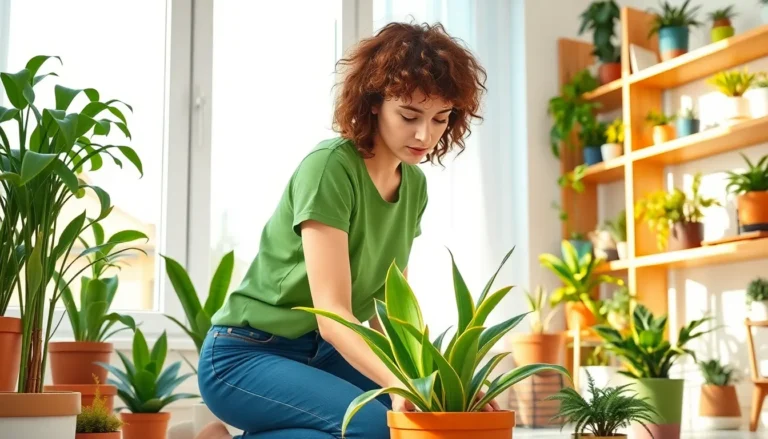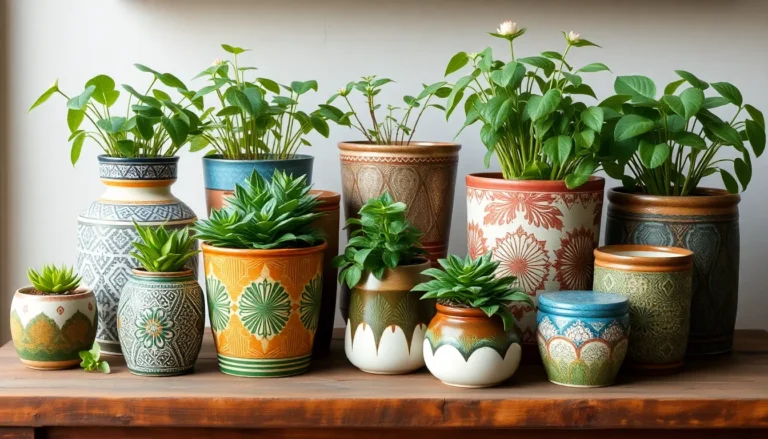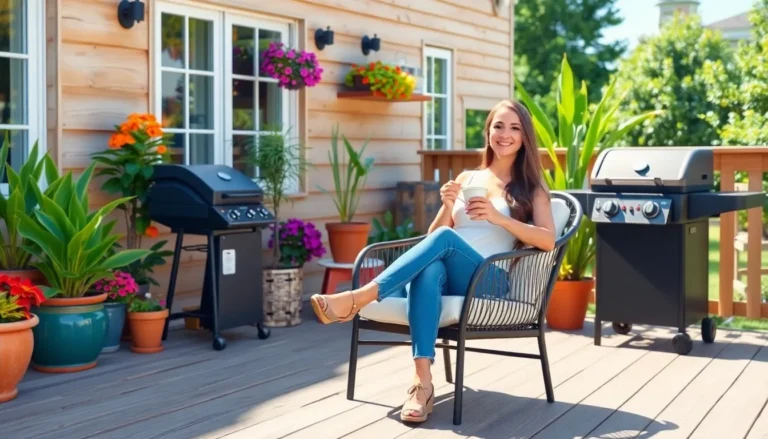Imagine transforming your home into a lush paradise without leaving the couch. Indoor tropical house plants are like a mini-vacation for your living space, bringing vibrant colors and fresh air right to your fingertips. These green beauties not only elevate your decor but also boost your mood and purify the air. Who wouldn’t want a little slice of the tropics while binge-watching their favorite show?
Table of Contents
ToggleBenefits Of Indoor Tropical House Plants
Indoor tropical house plants offer multiple advantages, transforming spaces into lively retreats. These plants contribute positively to both well-being and home aesthetics.
Improved Air Quality
Indoor tropical plants purify air effectively. They absorb toxins, such as formaldehyde and benzene, ensuring cleaner surroundings. In addition, many varieties release oxygen, enhancing overall air quality. Research indicates that plants like peace lilies and spider plants can remove nearly 87% of indoor pollutants within 24 hours. Incorporating these plants can lead to a healthier living environment, promoting better respiratory health and reducing the feelings of fatigue.
Aesthetic Appeal
Tropical house plants enhance interior decor with their vibrant colors and unique textures. They bring life into dull spaces, creating an inviting atmosphere. Varieties like pothos and monstera instantly draw attention, adding a dynamic touch to any room. Placing these plants strategically can complement furniture and wall colors, elevating design aesthetics. Moreover, they create a sense of calm and relaxation, helping individuals connect with nature even indoors.
Popular Indoor Tropical House Plants
Indoor tropical house plants offer both aesthetic charm and functional benefits. Choosing the right varieties enhances your home environment with lush greenery.
Peace Lily
Peace lilies (Spathiphyllum) thrive in low light, making them ideal for many indoor spaces. Their glossy green leaves and elegant white blooms contribute to a calming atmosphere. Peace lilies absorb indoor pollutants, including ammonia and formaldehyde, which improves overall air quality. This plant requires minimal maintenance; watering occurs roughly every week, or when the soil feels dry. Their ability to flourish in diverse conditions adds to their popularity among indoor plant enthusiasts.
Snake Plant
Snake plants (Sansevieria trifasciata), known for their striking upright leaves, add a sculptural element to interiors. These hardy plants adapt to various light conditions, including low and indirect light. Snake plants excel at filtering toxins like benzene and xylene, promoting cleaner air. Watering can take place every 2 to 6 weeks, depending on humidity levels, making them suitable for busy lifestyles. Their resilience and low care requirements solidify their status as a favorite among house plant collectors.
ZZ Plant
ZZ plants (Zamioculcas zamiifolia) are prized for their glossy, dark green foliage that complements any space. This plant thrives in low light and needs minimal water, which makes it perfect for beginners. ZZ plants effectively remove harmful chemicals, including xylene and toluene, from the air. They tolerate neglect and can survive without frequent watering, making them ideal for those with a hectic schedule. With their attractive appearance and low maintenance, ZZ plants remain a staple in indoor tropical plant selections.
Care Tips For Indoor Tropical House Plants
Caring for indoor tropical house plants enhances their growth and vitality. Understanding their needs ensures a thriving indoor garden.
Light Requirements
Tropical plants generally prefer bright, indirect sunlight. Peace lilies flourish in low-light areas, while snake plants adapt to various lighting conditions. Direct sunlight may scorch their leaves, so placing them near east or west-facing windows works best. ZZ plants tolerate low light but benefit from occasional bright light exposure. Rotating plants every few weeks promotes balanced growth and prevents leaning.
Watering Guidelines
Watering frequency varies based on plant species and environmental factors. Snake plants require minimal watering, allowing the soil to dry completely between sessions. Peace lilies like to stay slightly moist but don’t need overwatering, as soggy soil can lead to root rot. ZZ plants need infrequent watering, especially in winter months when growth slows. Checking soil moisture with fingers about an inch deep provides accurate hydration levels.
Soil and Fertilizer Needs
Selecting the right soil plays a crucial role in healthy plant growth. A well-draining potting mix enhances aeration and prevents waterlogging. Tropical plants thrive in mixes containing peat moss, perlite, or orchid bark. Fertilization usually occurs during the growing season, with a balanced liquid fertilizer applied every 4-6 weeks. Reducing fertilization in fall and winter aligns with their dormancy period, ensuring optimal nutrient availability.
Common Pests And Problems
Indoor tropical house plants can encounter various pests and problems that affect their health and appearance. Recognizing these issues quickly leads to effective solutions.
Identifying Pests
Common pests include spider mites, aphids, and mealybugs. Spider mites appear as tiny webs on leaves, causing discoloration. Aphids cluster on new growth, sucking sap and weakening plants. Mealybugs cover plant stems in a cotton-like substance, indicating an infestation. Other signs of pests involve yellowing leaves or stunted growth. Regular inspections help catch these threats early, ensuring indoor plants stay healthy and vibrant.
Solutions And Treatments
To address pests, isolation of affected plants prevents further spread. Insecticidal soap effectively treats spider mites and aphids. Neem oil serves as a natural pesticide, addressing various infestations. Regularly washing leaves with water removes dust and pests. Additionally, maintaining good air circulation reduces pest problems. Implementing these preventive measures promotes stronger plants while enhancing indoor air quality.
Indoor tropical house plants are more than just decorative elements; they’re essential companions for a healthier home. By choosing the right plants and providing proper care, anyone can create a lush oasis that enhances both air quality and mood. The vibrant colors and unique textures of these plants not only elevate interior design but also foster a sense of tranquility. With minimal maintenance and a few simple guidelines, individuals can enjoy the numerous benefits of tropical greenery. Embracing indoor plants is a rewarding journey that brings the essence of the tropics right into one’s living space.






